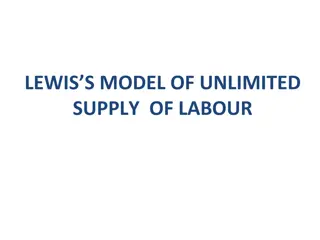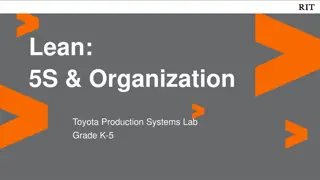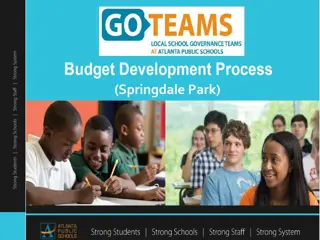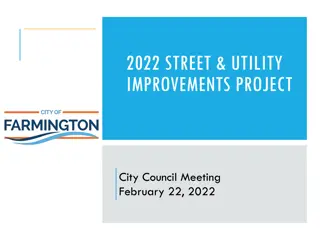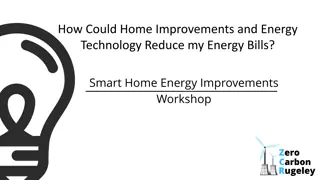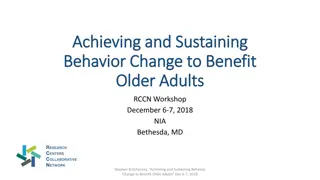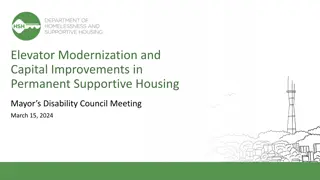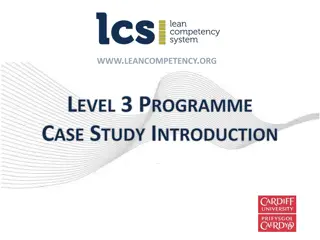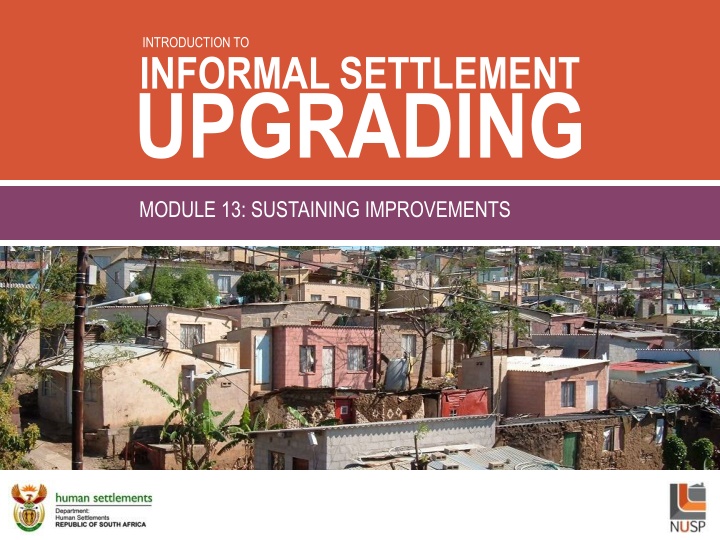
Sustaining Improvements in Informal Settlement Upgrading
This module focuses on the importance of planning for ongoing improvements and sustainability in the context of informal settlement upgrading. It covers topics such as developing a transformation plan, addressing critical issues, integrating plans into broader processes, and defining roles of different actors. Activities include creating a vision for transformation and promoting sustainable human settlements through active engagement and service delivery.
Download Presentation

Please find below an Image/Link to download the presentation.
The content on the website is provided AS IS for your information and personal use only. It may not be sold, licensed, or shared on other websites without obtaining consent from the author. If you encounter any issues during the download, it is possible that the publisher has removed the file from their server.
You are allowed to download the files provided on this website for personal or commercial use, subject to the condition that they are used lawfully. All files are the property of their respective owners.
The content on the website is provided AS IS for your information and personal use only. It may not be sold, licensed, or shared on other websites without obtaining consent from the author.
E N D
Presentation Transcript
INTRODUCTION TO INFORMAL SETTLEMENT UPGRADING MODULE 13: SUSTAINING IMPROVEMENTS
13 INTRODUCTION TO SUSTAINING IMPROVEMENTS INFORMAL SETTLEMENT UPGRADING Module purpose The purpose of this module is to introduce the issues, opportunities and operational requirements relating to the preparation of a Settlement transformation plan to secure long-term/ongoing improvements and sustainability of an informal settlement upgrade.
13 INTRODUCTION TO SUSTAINING IMPROVEMENTS INFORMAL SETTLEMENT UPGRADING Learning outcomes After participating in the module, you should be able to: Explain why it is necessary to plan for ongoing improvements and sustainability; Discuss the main issues that need to be addressed in the transformation plan; Integrate the transformation plan into the wider set of planning and budgeting processes; Identify the roles and responsibilities of community, municipal and provincial actors in sustaining improvements.
13 INTRODUCTION TO SUSTAINING IMPROVEMENTS INFORMAL SETTLEMENT UPGRADING Module content 1. Planning for sustainability 2. Developing the transformation plan 3. Issues to be addressed in the transformation plan 4. Writing a new story for South Africa
13 INTRODUCTION TO SUSTAINING IMPROVEMENTS INFORMAL SETTLEMENT UPGRADING Activity 13.1: Transformation vision Type of activity: Group work Timing: 40 minutes Purpose: To create a vision for transformation and sustainability and developing a transformation plan. Instructions: Working in your groups, draw a picture showing a vision of what the settlement you have been working with will look like in 10 years time.
13 INTRODUCTION TO SUSTAINING IMPROVEMENTS INFORMAL SETTLEMENT UPGRADING 1. Planning for sustainability Developing sustainable human settlements Breaking New Ground states that sustainable human settlements should be safe, secure developments with reliable and affordable basic services, adequate housing, and access to welfare, police, education, and health services. The development interventions made in an in situ upgrade must include active measures to ensure continuous service delivery and ongoing physical, social and economic improvements to promote sustainable human settlements. There are three key measures required: Measures to ensure the settlement is formally included in the operation and maintenance responsibilities of the municipality. Measures that ensure that facilities such as health and education which are produced and managed by provincial administrations are delivered to the settlements citizens Measure to engage the residents in actively undertaking improvements
13 INTRODUCTION TO SUSTAINING IMPROVEMENTS INFORMAL SETTLEMENT UPGRADING Activity 13.2: Planning for transformation Type of activity: Group work Timing: 15 minutes Purpose: To identify the various factors and actors that are necessary for sustaining improvements. Instructions: Choose one element of the infrastructure (eg roads, electricity, or water) within the picture you drew and one facility (eg school, clinic, or community centre). Tell the story of each element you have chosen responding to the questions in the Particpants Manual
13 INTRODUCTION TO SUSTAINING IMPROVEMENTS INFORMAL SETTLEMENT UPGRADING Sustaining physical assets The role of the municipality Put the assets onto their books. Assign or employ staff to manage and run them. Fund their operational expenditure. Make arrangements to both maintain the assets. Plan for their replacement when they are worn out.
13 INTRODUCTION TO SUSTAINING IMPROVEMENTS INFORMAL SETTLEMENT UPGRADING Sustaining physical assets cont. The role of the province Deliver , operationalise and maintain province facilities The role of the residents The sustainability of the upgrade is thus improved by ensuring the residents understand their responsibilities in respect of the proper use of facilities
13 INTRODUCTION TO SUSTAINING IMPROVEMENTS INFORMAL SETTLEMENT UPGRADING The components of sustainability Efficiency components Minimising the use of resources or maximizing reuse Creating opportunities for dual use and joint management of facilities Efficient layouts Energy savings At a settlement level designs that make the use of public transport more convenient and safer
13 INTRODUCTION TO SUSTAINING IMPROVEMENTS INFORMAL SETTLEMENT UPGRADING The components of sustainability cont. Economic sustainability Efforts to increase the number of jobs available during upgrading implementation. Access to employment outside the settlement in the longer term. Attention to improving short-term conditions around livelihoods. Providing support such as food security.
13 INTRODUCTION TO SUSTAINING IMPROVEMENTS INFORMAL SETTLEMENT UPGRADING The components of sustainability cont. Financial sustainability The capacity to secure payment for services. The capacity to levy and collect rates against the value of properties. Securing state funding. Ensuring a balance between cost and quality to reduce maintenance costs.
13 INTRODUCTION TO SUSTAINING IMPROVEMENTS INFORMAL SETTLEMENT UPGRADING Active citizenship The National Development Plan, Chapter 8 states that: Active citizenship in the field of spatial development will be supported and incentivized through a range of interventions including properly funded, citizen-led neighbourhood vision and planning processes and the introduction of social compacts from neighbourhood to city level. The concept of active citizenship is an important one for sustaining improvements in informal settlement upgrading - it means residents taking an active role in constructing their future and reduce dependency on government. In almost every community, associations are working to improve living conditions for themselves and for communities such as: Voluntary associations providing support Associations focusing on economic development Social activities The terminally ill Children and youth The elderly The very poor Business associations Co-operatives Stokvels Community gardens Sports clubs Cultural associations Choral/music groups Dancing clubs
13 INTRODUCTION TO SUSTAINING IMPROVEMENTS INFORMAL SETTLEMENT UPGRADING 2 Developing the transformation plan What is a transformation plan? A transformation plan is the outcome of a number of processes or activities directed at securing the long-term future of the informal settlement It focuses on defining long-term interventions and who is responsible for their execution It becomes a part of the municipal response to informal settlement upgrading and is built into wider municipal planning processes Developing the transformation plan must extend the community participation The transformation plan must identify the specific context for intervention, which is at the settlement level.
13 INTRODUCTION TO SUSTAINING IMPROVEMENTS INFORMAL SETTLEMENT UPGRADING The role of the community Communicating agreements reached between the community and the municipality in respect of planning and providing information goes a long way to avoiding disputes or conflict Community response to upgraded environments is improved through developing an understanding of mutual roles and responsibilities and of the actual best use of infrastructure and facilities provided in the process.
13 INTRODUCTION TO SUSTAINING IMPROVEMENTS INFORMAL SETTLEMENT UPGRADING The role of the municipality Municipalities carry the primary responsibility as development agents They are also responsible for the production of strategic planning documents Sector plans (including those on housing and infrastructure in particular) must address the inclusion of informal settlement upgraded settlements into operation and maintenance plans and budgets
13 INTRODUCTION TO SUSTAINING IMPROVEMENTS INFORMAL SETTLEMENT UPGRADING Including informal settlements in municipal planning The settlement must be recognised and included in the full spectrum of the municipality s administration. There are a number of planning and budgeting instruments through which inclusion is obtained: The Integrated Development Plan (IDP) The Spatial Development Framework (SDF) The Medium-Term Expenditure Framework (MTEF) The municipal annual budget Service Delivery Budget Implementation Plan (SDBIP) Asset management procedures
13 INTRODUCTION TO SUSTAINING IMPROVEMENTS INFORMAL SETTLEMENT UPGRADING Activity 13.3: The IDP Type of activity: Pair work Timing: 5 minutes Purpose: To elicit existing knowledge of the Integrated Development Plan (IDP). Instructions: Discuss what you know about the IDP with your partner. Make a list of key points. Think about why, when, who, and how in relation to the IDP.
13 INTRODUCTION TO SUSTAINING IMPROVEMENTS INFORMAL SETTLEMENT UPGRADING Activity 13.4: Video: The IDP Timing: 15 minutes Purpose: To build knowledge and understanding of the IDP. Instruction: As you watch the video, note any new points made that you did not include in your list of key points.
13 INTRODUCTION TO SUSTAINING IMPROVEMENTS INFORMAL SETTLEMENT UPGRADING Integrating with provincial planning to secure facilities The process of inclusion must begin early on and may need to occur at programme level to: Ensure the allocation of sufficient space. Schools in particular require extensive grounds. Ensure their development is funded, programmed and timely.
13 INTRODUCTION TO SUSTAINING IMPROVEMENTS INFORMAL SETTLEMENT UPGRADING Institutional arrangements Focus on overall sustainability. Targeting efficiency overall Assessments of layout performance Infrastructure efficiency assessments Tracking social amenity provision Keeping the long-term view Social programmes/support for community initiatives and enterprise Economic programmes/livelihood support Mainstreaming community participation at multiple levels/instances Monitoring and evaluation are key activities to ensure progress.
13 INTRODUCTION TO SUSTAINING IMPROVEMENTS INFORMAL SETTLEMENT UPGRADING Institutional arrangements Examples of Institutional Arrangements: Area-based Management (ABM) Organisational clustering/department clusters Dedicated work groups
13 INTRODUCTION TO SUSTAINING IMPROVEMENTS INFORMAL SETTLEMENT UPGRADING 3 Issues to be addressed in the transformation plan Activity 13.5: The transformation plan Type of activity: Group work Timing: 15 minutes Purpose: To apply what has been learnt in this course to the transformation plan and sustaining improvements. Instructions: Identify some activities that need to be included in the transformation plan for each of the critical elements set out in the Particpants Manual, in order to sustain improvements. You can refer to the notes in your Participants Manual. Each group will be given one topic to deal with. You will report back to plenary.
13 INTRODUCTION TO SUSTAINING IMPROVEMENTS INFORMAL SETTLEMENT UPGRADING Facilities management Attention should be paid to the management of facilities such as recreational facilities and community halls. For these to deliver services they need to be supported by community-based organisations which are empowered to make use of them. The management of the facilities must thus extend beyond caretaking to the active promotion of community pursuits. Central to achieving good use of these facilities is identification and partnerships with NGOs, community-based organisations and individual community members. Participatory processes during the upgrade process are useful mechanisms to establish these partnerships.
13 INTRODUCTION TO SUSTAINING IMPROVEMENTS INFORMAL SETTLEMENT UPGRADING Ensuring residents understand what will be expected of them Upgrading brings with it the need to alter behaviour to ensure residents: Properly use the infrastructure and facilities provided; Maintain the facilities provided on their own sites and in their own houses; Pay for municipal services. This reinforces the need to effectively communicate with residents Tools for communication include: Social media/use of mass SMS; Mass meetings; Community newspapers; Community radio; Community noticeboards.
13 INTRODUCTION TO SUSTAINING IMPROVEMENTS INFORMAL SETTLEMENT UPGRADING Housing support Housing support after the consolidation phase can assist to maintain momentum in improving housing over time. The support function may include: Design support; Building advice; Building materials yards; Credit.
13 INTRODUCTION TO SUSTAINING IMPROVEMENTS INFORMAL SETTLEMENT UPGRADING Livelihoods support/economic interventions The poverty and unemployment that characterizes informal settlements is the greatest obstacle to advancement. The upgrading process results in fairly large sums of money being spent in the informal settlement and so if possible it should be used to maximize work opportunities for residents by: Adopting labour-based approaches; Splitting work into small packages; Providing support for contractors to build their CIDB rating; Business support for small contractors. Economic imperatives obviously extend well beyond the upgrade itself and some interventions that hold promise are: The creation of space for economic activities in the layout; Creating concentrations or clusters of social and economic activities; Skills development; Co-operative development.
13 INTRODUCTION TO SUSTAINING IMPROVEMENTS INFORMAL SETTLEMENT UPGRADING Home-based enterprises Home-based enterprise offers an opportunity for income generation from individual houses. The types of enterprises that are appropriate include: Service: including hair salons, mechanics, traditional healers, taxi owners and shebeen operators; Retail: including spaza shops and frozen food retailers; Production: including fence and gate manufacturers, clothes makers and prepared food providers; Rental: including renting out a room in the main dwelling or space on the site for a dwelling to be erected. There is value in supporting existing home-based enterprises by: Providing information on how a home-based enterprise can be established; Promoting linkages to the formal sector within the vicinity of the informal settlement; Ensuring sites and house consolidation incorporates space for enterprise activities.
13 INTRODUCTION TO SUSTAINING IMPROVEMENTS INFORMAL SETTLEMENT UPGRADING Food security One means of offsetting the many negative components of poverty is by enabling food security. Most informal settlements have groups of residents who establish their own community vegetable gardens. This urban agriculture has been seen in a positive light and is supported in most municipalities. The potential for intensive small scale food production is supported by a growing body of knowledge which incorporates ecological principals. Examples of cultivation systems are: Permanent agriculture (permaculture); Hydroponic production/aquaponic systems (co-production of vegetables and fish); Organic production; Vertical gardens; Food forests. Efforts to jump-start urban agriculture have a poor success rate with many examples of significant investments standing idle. This indicates the importance of a well-designed approach that targets those who are currently involved or who demonstrate significant commitment
13 INTRODUCTION TO SUSTAINING IMPROVEMENTS INFORMAL SETTLEMENT UPGRADING Social capital formation Social capital is in a sense a rather intangible set of benefits that result from heightened social interaction and trust. Given that improved links are a characteristic of the existence of social capital, similar social forums may be one means to increase it. The usefulness of community-based organisations lies in their voluntary nature: They capture people s desire to do good; They build up self-esteem; They build organisational capacity and individual experience; They are unthreatening to political processes due to their narrow focus. If local conditions permit such CBOs could provide a useful resource and improving their capacity would increase their usefulness. This could be done by providing organisation development support to assist them to be effective. Such support could focus on improving management and accessing funding through writing business plans and funding proposals. If successful such an intervention could improve the capacity of these organisations to deliver on their particular mandates thus improving the lives of the people they touch.
13 INTRODUCTION TO SUSTAINING IMPROVEMENTS INFORMAL SETTLEMENT UPGRADING 4 Writing a new story for South Africa The National Development Plan talks about writing a new story for South Africa: The country must write a different story in the years ahead. In this new story, every citizen is concerned about the wellbeing of all other citizens, and the development of South Africa means the development of each and every one of us who lives here. We must build on our social solidarity, which through history and heritage has demonstrated our aspiration to create a caring South African society. In this new story, our nation s energies are focused both on attacking poverty and on expanding a robust, entrepreneurial and innovative economy. Over the next two decades and beyond, communities will need the resources and capabilities to become their own engines of development, and government must support this. We have to ensure that poor people have the environment, service and skills to improve their lives. At the same time, government must create the conditions and environment for higher levels of public and private investment to create jobs and ensure rising incomes .
13 INTRODUCTION TO SUSTAINING IMPROVEMENTS INFORMAL SETTLEMENT UPGRADING Activity 13.6: Putting it into practice Type of activity: Group work Timing: 20 minutes Purpose: To identify actions you can take to facilitate planning for transformation in your municipality. Instructions: In your work-integrated assignment, you are required to review the planning done for sustainability and transformation for the settlement you have been working with. In your groups, select two upgrading work streams: one infrastructural and one social. Draw up an action plan to review the planning that has been done for sustainability and transformation for your selected work streams: What information do you need to gather? (What must you find out?) Where will you find the information that you need?

